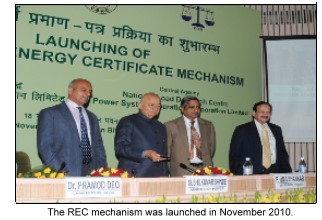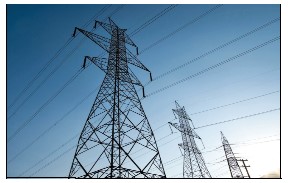 — Vibhav Nuwal, Director,
REConnect Energy Solutions Pvt Ltd
REConnect Energy Solutions
— Vibhav Nuwal, Director,
REConnect Energy Solutions Pvt Ltd
REConnect Energy Solutions Pvt Ltd is a venture focused on
renewable energy certificate (REC), energy efficiency and portfolio
management. REConnect provides complete life cycle services
starting from eligibility evaluation to trading of renewable energy
certificates, and was the first company to trade RECs in India.
Vibhav Nuwal takes us through the novel concepts of RPOs, RECs
and explains how these are traded on energy exchanges. Nuwal
also shares the growth plans of his company maintaining that the
REC market has a huge growth potential.
Please explain in simple terms what is meant by Renewable
Purchase Obligation (RPO) and the role of CERC and state
electricity regulatory commissions in the RPO mechanism.
RPO refer to new regulations that require all electricity
distribution companies and other large consumers of power
(subject to certain conditions) to consume a certain minimum
percentage of power from renewable sources. RPO is an
important part of the Electricity Act, 2003 (which has heralded
power reforms in the country), and is also an important element
in India's commitments on reduction of greenhouse gas
emissions in the international community. The RPO is a key
initiative by which governments are encouraging investments in
renewable energy capacity.
The national objective is to reach RPO of 15 per cent of total
consumption form RE sources by 2020, up from 6 per cent this year.
What are Renewable Energy Certificates (REC) and how do they
help in creating a nationwide balance of RPOs?
Along with the RPO regulations a tradable instrument, called
the Renewable Energy Certificate (REC), was created. In its
concept and design, the REC markets are not very different
from the carbon credit markets. The key difference is that while
carbon credits are traded internationally, RECs is an India
focused market.
The key concept behind RECs is that the renewable energy
potential across the country is very different. To develop that to
full potential places a varied burden on consumers across the
country. As an example, power consumption in Delhi is very
large, but the RE potential is low. Similarly, the RE potential in
coastal Gujarat is very high, but there are not enough
consumers who can pay (as yet) the high prices of power. REC
trading enables the burden to be shared, and thus spread the
cost. This will enable involving the entire country's consumers
to pay a little so that clean energy can be generated, rather than
some consumers taking up all the burden. A tradable market,
where for example RECs generated in Gujarat can be bought by
companies in Delhi, enables this.
In simplistic terms, such a transaction
will provide an additional return to the RE
generator (revenue from sale of RECs) and
add a cost to the person consuming
conventional (coal based, etc) power. This
additional return will encourage more
investment in RE capacity.
 Please summarize REConnect's activities
in the field of REC, encompassing the
entire value chain from accreditation to
trading of RECs.
Please summarize REConnect's activities
in the field of REC, encompassing the
entire value chain from accreditation to
trading of RECs.
REConnect is one of the largest companies
in the REC/RPO space. In the REC sector,
we provide complete life cycle services,
starting from eligibility evaluation,
contract structuring, state level
accreditation, central level registration,
regular issuance and tracking, and trading
of RECs. We were the first company to
trade RECs in India, on March 30, 2011.
Recently, we are increasingly called upon
by project developers for strategic advisory to help them choose
between various power sale options like REC, PPA with state,
etc. We are also helping projects achieve financial closure under
the REC mechanism.
In the RPO space, we are working with
some the largest companies and business
houses in helping them assess their
obligation, and develop a strategy to
meet them in a cost-effectively manner.
We are working with over 3,000 mw
of conventional capacity in
various capacities.
REConnect is a pioneer is developing a
knowledge- and research-focused
approach to the REC/ RPO market. Our
monthly newsletter, which has now over
14 issues is a repository of knowledge and
research in the REC space. We have also
recently launched an online RPO
calculator—a first of its kind in India (and
possibly the world!).
Take us through your expansion plans,
including spreading of your geographical
footprint.
We currently have offices in six locations in
the country. Through these, we are working on projects in 14
states. In seven of these, we have been the first applicants for REC.
We see significant growth opportunity in this market in the
future. Initiatives include new products and services, more indepth
research-we already do a lot of analytics and research
that is accessible only to our clients at this point-and more work
on decision support for RE projects.
 Of all sources of clean energy which holds maximum potential
with respect to earning maximum REC value?
Of all sources of clean energy which holds maximum potential
with respect to earning maximum REC value?
RECs are awarded on the basis of actual generation. Every 1.000
units, or 1 MWH is equal to 1 REC. Therefore, projects potential
for REC generation depends on the technology. For example, the
standard plant load factor (PLF; capacity utilization) for a wind
turbine is 20 per cent of the installed capacity, while for a
biomass project it can be up to 90 per cent or even higher.
Can you explain the difference between, and the need for
having, solar and non-solar RECs?
The cost of building solar capacity is very different from other
forms of renewable energy, say wind. As an example, 1 mw of
installed capacity in solar project can cost between

10-13 crore,
while it will cost between

5 - 6.5 crore in a wind project.
Since the costs are so different, it is necessary to develop two
different RECs-solar and non-solar. The RPO in each state is
also further sub-divided in solar and non-solar RPO. As an
example, in Gujarat the RPO is 6 per cent. However, this is
further divided as 0.5 per cent of solar and 5.5 per cent as nonsolar
RPO.
Do you expect the 1 GW of solar capacity envisaged by the
National Solar Mission by 2013 have a big impact on solar-RECs?
Almost all of the capacity under the National Solar Mission will
be under the preferential tariff arrangement. Therefore, it will
not be eligible for RECs.
What is the total value of RECs generated till date, and what is
your reading of future trends?
The total RECs issued so far by NLDC is close to 324,000. At the
floor price of RECs (

1,500/REC), this represents a total value of

48.5 crore.
We expect the number of RECs issuance in the market to
increase dramatically. As an example, our analysis suggested
that in October, only about 168 mw of projects got REC issuance,
while the accredited capacity exceeded 1,600 mw.
What is your overall view on the robustness of the existing REC
architecture and how successful has it been in promoting
renewable energy generation? What are your suggestions for
its further improvement?
The key question facing the REC market is the enforcement of
RPO regulations. While states have done a very good job in
creating the regulations, their enforcement remains a key
question. Without strong enforcement, where defaulters are
penalised, adequate demand for RECs will not materialize. We
will only the answer after March 2012, when companies will be
required to demonstrate compliance. Strong enforcement will
be absolutely critical to make this novel market work.
TRADING VOLUMES OF RECs* |
| |
PXIL |
IEX |
Total |
| Mar-11 |
274 |
150 |
424 |
| Apr-11 |
0 |
260 |
260 |
| May-11 |
4,500 |
14,002 |
18,502 |
| Jun-11 |
483 |
15,902 |
16,385 |
| Jul-11 |
3,900 |
14,668 |
18,568 |
| Aug-11 |
3,000 |
22,096 |
25,096 |
| Sep-11 |
4,977 |
41,385 |
46,362 |
| Oct-11 |
3,201 |
92,303 |
95,504 |
| *Market-cleared volumes in number of RECs |